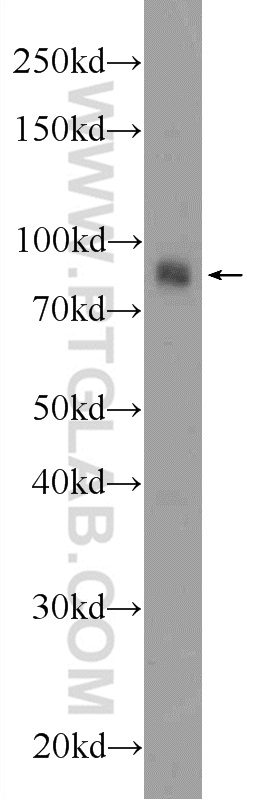验证数据展示
经过测试的应用
| Positive WB detected in | COS-7 cells |
推荐稀释比
| 应用 | 推荐稀释比 |
|---|---|
| Western Blot (WB) | WB : 1:500-1:1000 |
| It is recommended that this reagent should be titrated in each testing system to obtain optimal results. | |
| Sample-dependent, Check data in validation data gallery. | |
产品信息
23909-1-AP targets AFAP1L1 in WB, ELISA applications and shows reactivity with human, monkey samples.
| 经测试应用 | WB, ELISA Application Description |
| 经测试反应性 | human, monkey |
| 免疫原 | AFAP1L1 fusion protein Ag21006 种属同源性预测 |
| 宿主/亚型 | Rabbit / IgG |
| 抗体类别 | Polyclonal |
| 产品类型 | Antibody |
| 全称 | actin filament associated protein 1-like 1 |
| 别名 | AFAP1 like protein 1, AFAP1L1 |
| 计算分子量 | 768 aa, 86 kDa |
| 观测分子量 | 75-86 kDa |
| GenBank蛋白编号 | BC125093 |
| 基因名称 | AFAP1L1 |
| Gene ID (NCBI) | 134265 |
| RRID | AB_2879358 |
| 偶联类型 | Unconjugated |
| 形式 | Liquid |
| 纯化方式 | Antigen Affinity purified |
| UNIPROT ID | Q8TED9 |
| 储存缓冲液 | PBS with 0.02% sodium azide and 50% glycerol , pH 7.3 |
| 储存条件 | Store at -20°C. Stable for one year after shipment. Aliquoting is unnecessary for -20oC storage. |
背景介绍
Actin Filament-Associated Protein of 110 kDa (AFAP-110/AFAP1) is an adaptor protein with multiple protein binding motifs that is known to function as both an actin binding protein and a cSrc activating protein. A homology search of AFAP1 recently identified AFAP1L1 which has a similar sequence, domain structure and cellular localization. AFAP1L1 is highly expressed in human breast, colon and brain tissue. AFAP1L1 interacts with cortactin and involves the invadosomes formation. AFAP1L1 as a prognostic marker has a role in the progression of spindle cell sarcomas.
实验方案
| Product Specific Protocols | |
|---|---|
| WB protocol for AFAP1L1 antibody 23909-1-AP | Download protocol |
| Standard Protocols | |
|---|---|
| Click here to view our Standard Protocols |
